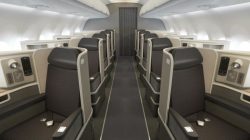Today, I stumbled across an article that provides didactic insight into business lessons that can be learned from the airline industry. Published yesterday in Inc. magazine, A Lesson on Cost From American Airlines, assesses how maintaining control over shifts in the “cost curve” can have a real impact on profitability. Once one of the industry cost leaders, alongside Southwest Airlines, American is currently restructuring under Chapter 11 bankruptcy protection after filing last November.
The YouTube clip above was aired shortly after 9/11, and sends a chilling, yet powerful message: despite the volatility of the airline industry, American Airlines remained committed to flying its colors with ardor. The carrier lost two aircraft in the September 11, 2001 terrorist attacks, and suffered from the economic downturn that followed, along with rising oil prices, and war in the Middle East.
Yet, compared to its competitors, American’s costs-per-seat-mile were among the lowest in the US industry, according to the Inc. article. However, over the years, AA lost sight of their control over the cost curve, focusing instead on brand strength and customer service to drive up revenue performance.
While important drivers in business operations, these actions could not recoup AA’s slipping position in cost control. The article argues that in an industry where product offerings are relatively undifferentiated, and input costs are high, cost control decisions cannot be ignored. In other industries, cost position, relative to competitors, isn’t as important, since other areas, such as an emphasis on customer service, can insulate a company to achieve higher profit margins. The article cites retail as an example of this.
However, within the airline industry, such a strategy cannot be employed for three critical reasons:
-
- Undifferentiated Products: an airline seat is an airline seat; it is a relatively standardized commodity. The average traveler will trade down to purchase the ticket price that provides them the best value. If cost structure differences exist between competitors (which they do drastically in the airline industry) the winner will always be the one with the lower operating model, who also manages to steal the customers if it offers good value for a seat price that it can afford to sell and earn a profit.
- Volatile prices and/or input costs: airlines are capital-intensive: aircraft purchases are expensive. In addition, variable costs can grow over time in the form of fuel and labor. Lacking a lean cost structure causes a competitor to become unprofitable very quickly
- Fluctuating demand and/or persistent overcapacity: another moving data point that can easily put a carrier at a huge disadvantage if it floods a market with a glut of seat capacity, where supply is in excess of demand. An unfilled seat is a sunk cost to an airline, plain and simple, and many unfilled seats add up quickly.
In American’s case, the bankruptcies of United, Delta, US Airways and Northwest Airlines, between 2002 and 2005, set an end to the cost structure disparities between it and its main competitors. The restructurings of the aforementioned carriers allowed them to either re-negotiate their union contracts and either shed or defer some pension obligations.
Moreover, every single legacy carrier has undergone a mega consolidation with another major carrier (US Airways with America West, Delta with Northwest, and United with Continental) allowing each of them to streamline operations and achieve economies of scale, thereby attaining many cost advantages by combining synergies.
While a step forward in the right direction, filing for Chapter 11 will not come without pain for AA. The carrier announced this month that 13,000 jobs will be shed, and the carrier will eliminate many unprofitable routes. This will shrink its presence in markets where it does command a loyalty following from frequent fliers, leaving opportunities on the table for competitors and causing ticket prices to rise.
Perhaps such movements up and down the cost curve are cyclical, and once American is able to leverage their brand with a better balance sheet, other carriers will have to react in order to avoid retrenchment to fill the same void.
Read more here:



